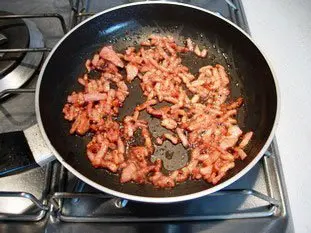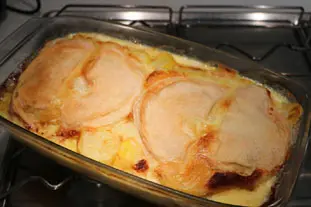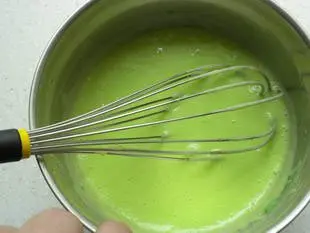This site uses only a few technical cookies necessary for its operation. By continuing to browse, you accept their use.
To find out more...
To find out more...
Balancing flavours

In the kitchen, we sometimes use ingredients that can be a little overwhelming in taste.
Grilled lardons, for example, are very good, they give a great taste to a lot of recipes where they are added, but you have to be objective, they're still pretty fatty!
Grilled lardons, for example, are very good, they give a great taste to a lot of recipes where they are added, but you have to be objective, they're still pretty fatty!
8,834 5/5 (17 reviews)
Keywords for this post:FlavorsTastesBalanceNuanceLast modified on: November 7th 2020
Balancing flavours
And as a result, this fatty, suave side can sometimes be a little too much, when you add these lardons to something a little busy, tone on tone, for example a tartiflette.
The point here is not to try and lighten things up (after all, "fat is life"), but rather to try and accompany this flavor.
You might think that discarding the cooking fat and keeping only the "dry" lardons, and/or blanching them before cooking, would reduce the taste? Yes, a little, but not that much, in fact. They'll certainly be lower in calories, but their strong taste will still be there.
By proceeding in this way, you'll give the grilled lardons a hint of acidity that will balance, or counterbalance, the fatty, suave, original flavour.
This delicate nuance is the perfect accompaniment to your recipe.
So, you've seen the general rule: when there's a risk of a little too much fat, compensate with a little acidity.
Another example in the same spirit: enjoy rillettes (rather fatty) with a good glass of Bourgogne aligoté (rather acidic), each revealing the other, it's a delight...
Note that it also works the other way round, which is why creams or lemon preparations, for example, are often generously creamed or buttered to soften the acidity a little.
In short: with things that are quite fatty in taste, think about adding a little acidity, and in the other direction, a little cream or butter to a preparation that's too acidic.

The point here is not to try and lighten things up (after all, "fat is life"), but rather to try and accompany this flavor.
You might think that discarding the cooking fat and keeping only the "dry" lardons, and/or blanching them before cooking, would reduce the taste? Yes, a little, but not that much, in fact. They'll certainly be lower in calories, but their strong taste will still be there.
So what can you do?
I suggest giving your lardons a sort of tonic accent:- Grill them as you usually do (say, a small frying pan over high heat, with the lardons alone in it).
- Once they're toasted to your liking, add 2 or 3 tablespoons of vinegar all at once. Be careful, it will boil and release very pungent fumes (start your hood first if you haven't already).
- Continue cooking for about 15/20 seconds, until most of the vinegar has evaporated.
- Remove from heat, and use in your recipe (allow to cool if necessary).
By proceeding in this way, you'll give the grilled lardons a hint of acidity that will balance, or counterbalance, the fatty, suave, original flavour.
This delicate nuance is the perfect accompaniment to your recipe.
So, you've seen the general rule: when there's a risk of a little too much fat, compensate with a little acidity.
Another example in the same spirit: enjoy rillettes (rather fatty) with a good glass of Bourgogne aligoté (rather acidic), each revealing the other, it's a delight...
Note that it also works the other way round, which is why creams or lemon preparations, for example, are often generously creamed or buttered to soften the acidity a little.

In short: with things that are quite fatty in taste, think about adding a little acidity, and in the other direction, a little cream or butter to a preparation that's too acidic.
Lasts posts
Butter vs. grease
We often read in a recipe where a pastry is put into a mould that, just before pouring, the mould should be buttered or greased. But what's the difference between these 2 terms?December 1st 20251,0315
Getting out of the fridge early
Very often when you're cooking, you need to take food or preparations out of the fridge, to use them in the recipe in progress. There's nothing tricky about this: you just take them out of the fridge and use them, usually immediately, in the recipe. But is this really a good method?November 24th 20251,1385
Who's making the croissants?
When you look at a bakery from the outside, you naturally think that in the bakery, the bakers make the bread, and in the laboratory, the pastry chefs make the cakes. It's very often like that, with each of these professions having quite different ways of working, but sometimes there's also one...November 23th 20251,030
Oven height
When we put a dish or cake in the oven, we naturally tend to put it on the middle shelf, and that's what we usually do. But in some cases, this position and height can be a little tricky, so let's find out why.October 8th 20252,8055
The importance of sieving
In recipes that use a fine powder (flour, powdered sugar, etc.), you'll often see the advice to sift before using it. To sift is to pass the powder in question through a sieve (a very fine strainer) before incorporating it into your recipe. It's often advice, but is it really useful?September 3rd 20257,5643
Other pages you may also like
Butter doesn't make you fat, unless you eat too much of it.
Whenever I'm discussing cooking and recipes, there is one idea which comes up frequently, like this: "Oh no! But that's got butter in it" (I should add, for the sake of accuracy, that this is something I hear more frequently from women, who are almost all concerned with keeping their figure). ...March 26th 201245 K4.5
Making the most of seeds: Dry roasting
In cooking, and particularly in baking, there are a lot of seeds we can use, such as linseed, sesame, poppy, etc. Usually, recipes simply say to add them just as they are to the mixture or dough. To make a seeded loaf, for example, prepare a plain bread dough as usual, then, towards the end of...January 30th 201562 K4.0
Should a sausage be pricked before cooking?
If you are using sausages in a recipe, you may have already asked yourself the question: Should you prick it before cooking it, or not? You will certainly find as many opinions "you should prick" as "you should not". Let's try to untangle all this.September 29th 201848 K4.1
Cleaning endives
If you buy your endives elsewhere than in supermarkets, and in this case the best is of course from a market gardener, he or she is the one who planted and harvested them, in this case you will have endives full of earth or sand, depending on where they were grown, which is normal and reassuring, we...March 24th 202026 K4.6
Tranché, dissociated, failed, in short... missed!
When preparing a sauce or a cream, there's always a (small) risk that the creamy preparation you're working on will suddenly separate into two parts of different textures: a liquid part, for example, and a more or less solid part, or even become lumpy. It's terribly frustrating, but we'll see...June 19th 202313 K5
Post a comment or question
Follow this page
If you are interested in this page, you can "follow" it, by entering your email address here. You will then receive a notification immediately each time the page is modified or a new comment is added. Please note that you will need to confirm this following.
Note: We'll never share your e-mail address with anyone else.
Alternatively: you can subscribe to the mailing list of cooling-ez.com , you will receive a e-mail for each new recipe published on the site.









